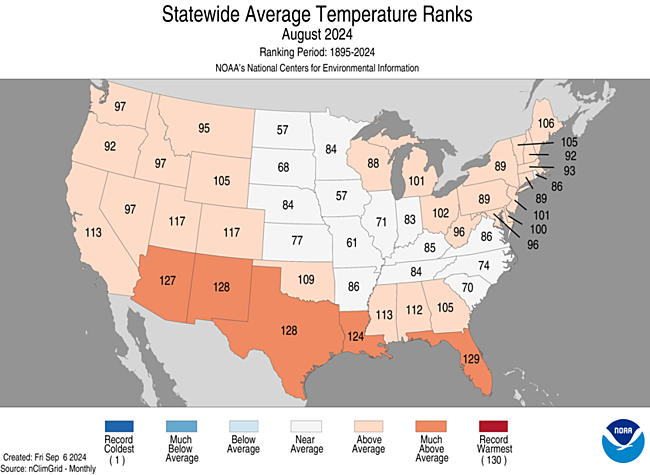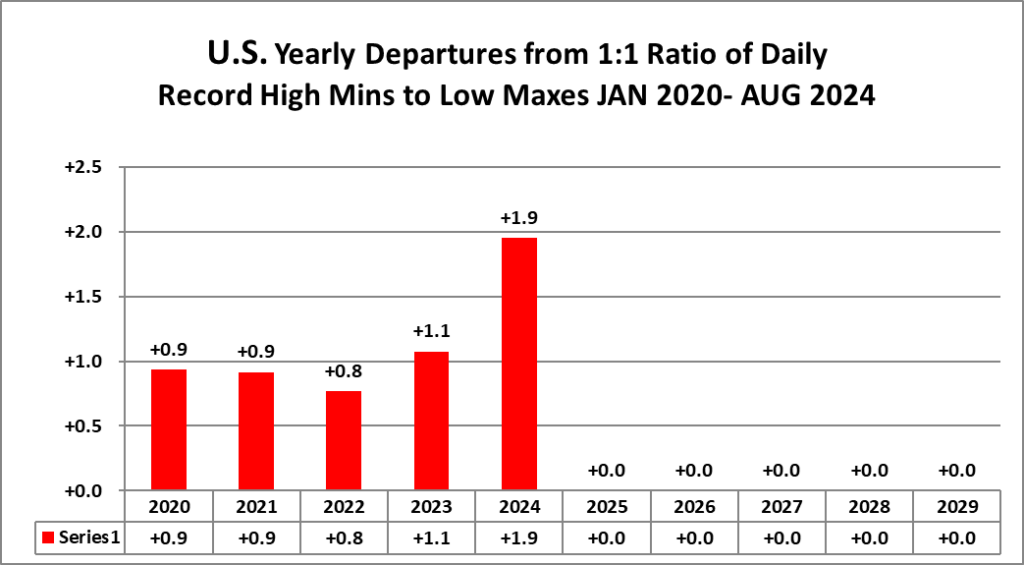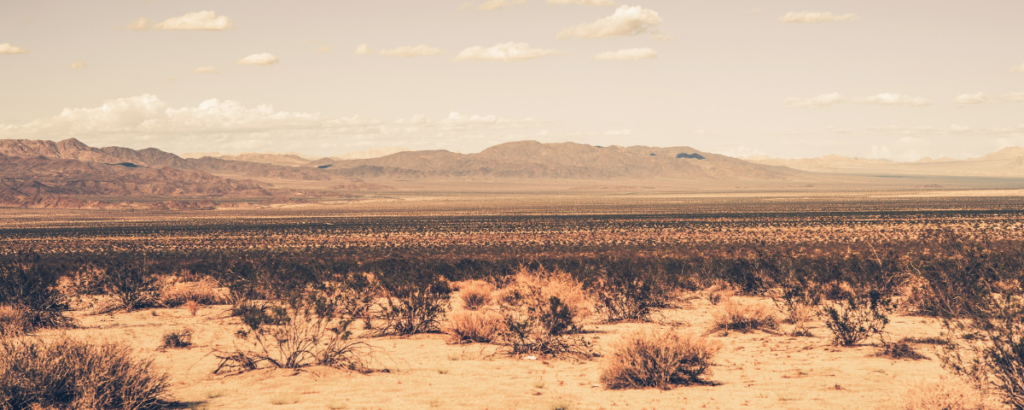The main purpose of this ongoing blog will be to track planetary extreme, or record temperatures related to climate change. Any reports I see of ETs will be listed below the main topic of the day. I’ll refer to extreme or record temperatures as ETs (not extraterrestrials).😉
Main Topic: U.S. Summer 2024 Record Scoreboard and Climatological Review
Dear Diary. It’s time once again for our monthly climatological review. Here on this site, we usually present monthly summaries near the 10th of each month, and each is available by clicking the link below:
https://guyonclimate.com/category/record-scoreboard-climatological-reviews
I’m repeating this mantra every month:
August 2024 using 1901-2000 mean data got ranked by the National Center for Environmental Information for the lower 48 states as 15th warmest or 116th coolest since records began being kept in 1895 at +1.19°F(1.06°C) above average.
The above data was from:
https://www.ncdc.noaa.gov/cag/national/rankings
August was hot relative to temperature averages for the majority of U.S. states. Most reports of record heat came from the Southwest, south-central states, Northeast, and Florida throughout the month. Most reports of record chill came from the Midwest throughout the month.

I’ll reiterate- Great job done by NOAA seasonal forecasters! And Summer 2024 turned out to be very hot for most since it was the 4th warmest on record since 1895:

You can check out record totals for yourself on my NCEI record archives:
NCEI Record Count Archive – Guy On Climate
Here are my two U.S. Daily Record Scoreboards updated through 9/08/2024 (data compiled from the following NCEI site):
https://www.ncdc.noaa.gov/cdo-web/datatools/records
I’m also keeping tabs on record report totals to verify a scientific study I helped to complete in the decade of the 2000s. We’ll eventually see how skewed ratios of record warm to cold reports get by the year 2100, which the study mentions as 50-1 for DHMX vs. DLMN:
Brand new for 2024: I’ve started to add NCEI anomalies (F° departure from 1901-2000 data) on my record scoreboards. I’d like these record scoreboards to be a quick and dirty reference tool and a template for future NCEI record site graphics.


DHMX= Daily High Max Reports. DLMN= Daily Low Min Reports. DHMN= Daily High Min Reports. DLMX=Daily Low Max Reports.
Boldly highlighted red, blue, or purple colored months, such as December 2023 and June 2021, that have ratios of >10 to 1 daily warm low records or <1 to 10 daily warm to low records are either historically hot or cold, most of which have made news. NCEI rankings are for the lower 48 states with the warmest ranking since 1895 of average temperatures being 130 and 1 being the coldest as of 2024. Blue colors represent cold months and red warm. Those months and years with counts close to a 1 to 1 ratio of highs to lows are colored black. All-time record hottest or coldest months and years are boldly colored in purple. NCDC rankings have been color coded (under tabs in each file) such that values of 54 to 74 are black representing neutral months or years (+ or – 10 from the average ranking of 64).
Totals are record reports for the entire United States including all territories minus those from Alaska. I’ve subtracted those from Alaska to get a better representation of what has occurred across the lower 48 states in association with lower 48 state rankings.
August 2024 had approximately a 15 to 6 ratio of record DHMX to DLMN individual record counts, so the color I used for that month was red on the top chart.
August 2024 had approximately a 2 to 1 ratio of record DHMN to DLMX individual record counts, so the color I used for that month was red on the bottom chart.
Due to climate change, we are seeing fewer blue colors on these Record Scoreboards with time.
The average temperature lower 48 state ranking for August 2024 was 116, which was colored red since it was warmer than average.
I color rankings of +10 to -10 from the average ranking for the lower 48 states of 65 black, indicating that these are near average temperature wise. The top warmest ranking for 2024 would be 130 since rankings began in 1895.
We are seeing that so far September 2024 has been above average for most of the country so far. Meteorological models forecast a cooling trend for the West with a above average temperatures from the Midwest into the Northeast with near average temperatures in the Southeast for the next ten days. After that there club be a big pattern change with the West warming and the East cooling. September 2024 should be above average for the lower 48 states as a whole, but probably will be the coolest of the three Fall 2024 months relative to average.
Interestingly, overall ratios for 2024 are now higher than historic yearly ratios for the 2020s as shown here…which is no surprise given how hot the globe is coming off an El Niño sea surface pattern:


Here is much more detailed climatology for August 2024 as complied by NOAA:
Assessing the U.S. Climate in August 2024
Three tropical systems brought heavy rain and wind to the U.S. and its territories in August; it was the fourth-warmest summer on record for the contiguous U.S. and many cities were gripped by record heat

Published
September 10, 2024
Related Links
August 2024 U.S. Climate Report (Available September 13, 2024)
National Temperature and Precipitation Maps
Climatological Rankings Explained
State of the Climate Summaries
Key Points:
- The average temperature of the contiguous U.S. in August was 74.0°F, 1.9°F above average; the month tied with August 1998 as the 15th warmest in the 130-year record.
- Debby made landfall as a Category 1 Hurricane on August 5 near Steinhatchee, Florida and a second landfall as a tropical storm near Bulls Bay, South Carolina on August 8. The storm brought heavy rains, flooding and strong winds to the Southeast.
- In Puerto Rico, before strengthening as a hurricane, Tropical Storm Ernesto brought significant flooding and caused nearly half of the island to lose power due to its strong winds during August 13–14.
- Rain bands and strong winds from Hurricane Hone impacted Hawaii during August 24–25, causing flooding and power outages.
- A number of cities across the West, South and East Coast each experienced their warmest summer on record.
- About 30% of the contiguous U.S. was in drought by the beginning of September, up a little over 10% from the end of July.
Other Highlights:
Temperature

August temperatures were above average across the western and northeastern contiguous U.S., with near-record warmth in the southern states. Florida had its second-warmest August on record while Texas and New Mexico each had their third-warmest August on record. Conversely, near- to below-average temperatures were observed from North Dakota to the Carolinas.
The Alaska statewide August temperature was 49.6°F, 0.1°F above the long-term average, ranking in the middle third of the 100-year period of record for the state. Near- to cooler-than-average temperatures were observed throughout much of the state, with above-average temperatures occurring across parts of the North Slope and from the Northeast Gulf to the Panhandle.

The meteorological summer (June–August) average temperature for the contiguous U.S. was 73.8°F, 2.5°F above average, which is the fourth-warmest summer in the 130-year record. Temperatures were above average to record warm across much of the western U.S. and from the Gulf Coast to the Northeast. Arizona, California, Florida, Maine and New Hampshire each had their warmest summer on record.
The Alaska summer temperature was 51.7°F, 1.3°F above the long-term average, ranking in the warmest third of the record for the state. Temperatures were above-average across much of the state, while parts of the West Coast and Bristol Bay saw near-average summer temperatures.
For the January–August period, the average contiguous U.S. temperature was 56.9°F, 3.0°F above average, ranking second warmest on record. Temperatures were above average across the contiguous U.S., while record-warm temperatures were observed in parts of the Northeast, Ohio Valley and South. New Hampshire, Vermont and West Virginia each saw their warmest January–August period on record.
The Alaska January–August temperature was 31.2°F, 2.4°F above the long-term average, ranking in the warmest third of the historical record for the state. Most of the state was warmer than average.
Precipitation

August precipitation for the contiguous U.S. was 2.46 inches, 0.16 inch below average, ranking in the driest third of the historical record. Precipitation was below average across much of the South from the southern California coast to the central Gulf Coast, extending into the Ohio Valley. Alabama and Mississippi had their driest August on record, with Tennessee ranking second driest. Conversely, precipitation was above average along the East Coast, across the central Rockies, Northern Tier states and from northern California to Washington State. New York had its fourth-wettest August on record.
Alaska’s average monthly precipitation ranked in the wettest third of the historical record. Drier-than-average conditions dominated the Aleutians and central to southern Panhandle regions, while mostly above-average precipitation dominated the remainder of the state.

The U.S. summer precipitation total was near-average with a total of 8.30 inches, ranking in the middle third of the June–August record. Precipitation was above average across portions of the Upper Midwest, and in parts of the Northeast, Southeast, Gulf Coast and central Rockies. Michigan saw its fifth-wettest summer on record. Summer precipitation was below average from the Ohio Valley to the Gulf Coast, from the northern Rockies to California and across portions of the central and southern Plains. West Virginia had its fifth-driest summer on record.
For summer season precipitation, Alaska ranked in the wettest third of the record with wetter-than-average conditions observed across most of the state. Precipitation was below average in parts of the South Panhandle, Southeast Interior and the Aleutians.
The January–August precipitation total for the contiguous U.S. was 22.93 inches, 2.23 inches above average, ranking 10th wettest in the 130-year record. Precipitation was above average across a large portion of the Upper Midwest, Northeast and Deep South, with Rhode Island and Connecticut both ranking second wettest. Conversely, precipitation was below average across parts of the Northwest, northern Plains, central Appalachians and west Texas during the January–August period.
The January–August precipitation for Alaska ranked in the wettest third of the 100-year record.
Billion-Dollar Disasters
One new billion-dollar weather and climate disaster was confirmed in August 2024, a severe weather event that impacted the central and eastern U.S. in mid June.
There have been 20 confirmed weather and climate disaster events this year, each with losses exceeding $1 billion. These disasters consisted of 16 severe storm events, one tropical cyclone event, one wildfire event and two winter storms. The total cost of these events exceeds $53.0 billion, and they have resulted in at least 149 fatalities.
The U.S. has sustained 396 separate weather and climate disasters since 1980 where overall damages/costs reached or exceeded $1 billion (including CPI adjustment to 2024). The total cost of these 396 events exceeds $2.780 trillion.
Other Notable Events
The high temperature of 89°F at Deadhorse Airport on August 6 broke the previous all-time record high of 85°F set in July 2016. This is also the highest temperature on record in Alaska north of 70°N.
Slow moving thunderstorms on August 18 caused flash flooding, several mudslides and numerous water rescues and prompted hundreds of evacuations on Long Island, New York and across parts of Connecticut.
On August 24, Palisades Tahoe, California, reported its first August snowfall since 2004.
A heat wave towards the end of August broke all-time heat records:
- Abilene, Texas: 113°F on August 21
- Medicine Lodge, Kansas: 115°F on August 24
Drought
According to the September 3 U.S. Drought Monitor report, about 30% of the contiguous U.S. was in drought, up a little over 10% from the end of July. Drought or abnormally dry conditions expanded or intensified this month across much of the Deep South, Great Plains and Tennessee and Ohio Valleys, and in the Great Basin to California and in the interior Pacific Northwest. Parts of West Virginia and Ohio experienced exceptional drought for the first time in the 25-year U.S. Drought Monitor history. Drought contracted or was reduced in intensity across much of Hawaii and the Mid-Atlantic, and parts of the Northeast, West and Central Plains.
Monthly Outlook
Above-average temperatures are favored to impact areas across Florida and the western portions of the U.S. in September, while below-average precipitation is likely to occur across the Upper Midwest. Drought is likely to persist across the Northwest, Central Plains, Ohio Valley and Hawaii. Visit the Climate Prediction Center’s Official 30-Day Forecasts and U.S. Monthly Drought Outlook website for more details.
Significant wildland fire potential for September is above normal across portions of the West, Ohio Valley, Lower Mississippi Valley and Hawaii. For additional information on wildland fire potential, visit the National Interagency Fire Center’s One-Month Wildland Fire Outlook
This monthly summary from NOAA’s National Centers for Environmental Information is part of the suite of climate services NOAA provides to government, business, academia and the public to support informed decision-making. For more detailed climate information, check out our comprehensive August 2024 U.S. Climate Report scheduled for release on September 13, 2024. For additional information on the statistics provided here, visit the Climate at a Glance and National Maps webpages.
Here are more “ETs” recorded from around the planet the last couple of days, their consequences, and some extreme temperature outlooks, as well as any extreme precipitation reports:
Here is more new August 2024 climatology. (More can be found on each daily post during September.):
Here is More Climate News from Tuesday:
(As usual, this will be a fluid post in which more information gets added during the day as it crosses my radar, crediting all who have put it on-line. Items will be archived on this site for posterity. In most instances click on the pictures of each tweet to see each article. The most noteworthy items will be listed first.)